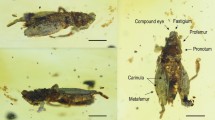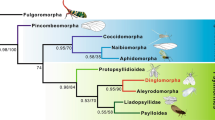Abstract
Recently, we are witnessing an increased appreciation for the importance of the fossil record in phylogenetics and testing various evolutionary hypotheses. However, this approach brings many challenges, especially for such a complex group as aphids and requires a thorough morphological analysis of the extinct groups. The extinct aphid family Szelegiewicziidae is supposed to be one of the oviparous lineages in aphid evolution. New material from the rock fossil deposits of Shar Teg (Upper Jurassic of Mongolia), Baissa (Lower Cretaceous of Siberia-Russia), and Burmese amber (Upper Cretaceous of Myanmar) allowed us to undertake a more detailed examination of the morphological features and carry out an analysis of the taxonomical composition and evolution of the family. This led us to the conclusion that evolution of the body plan and wing structure was similar in different, often not closely related groups, probably as a result of convergence. Additionally, we present a description of a new genus and two species (Tinaphis mongolica Żyła &Wegierek, sp. nov., and Feroorbis burmensis Wegierek & Huang, gen. et sp. nov.) that belong to this family.




Similar content being viewed by others
References
Blackman RL, Eastop V (2006) Aphids on world’s herbaceous plants and shrubs. Wiley, Chichester http://www.aphidsonworldsplants.info
Dixon AFG, Kindlmann P, Lepš J, Holman J (1987) Why there are so few species of aphids, especially in the tropics. Am Nat 129:580–592
von Dohlen CD, Rowe CA, Heie OE (2006) A test of morphological hypotheses for tribal and subtribal relationships of Aphidinae (Insecta: Hemiptera: Aphididae) using DNA sequences. Mol Phylogenet Evol 38:316–329. https://doi.org/10.1016/j.ympev.2005.04.035
Favret C Aphid species file. Version 5.0/5.0. [2016.01]. http://Aphid.SpeciesFile.org Accessed 1 March 2017
Grimaldi DA, Engel MS, Nascimbene PC (2002) Fossiliferous Cretaceous amber from Myanmar (Burma): its rediscovery, biotic diversity, and paleontological significance. Am Mus Novit 3361:1–71. doi.org/10.1206/0003-0082(2002)361<0001:FCAFMB>2.0.CO;2
Heie OE, Wegierek P (2011) A list of fossil aphids (Hemiptera, Sternorrhyncha, Aphidomorpha). Upper Silesian Museum, Bytom
Huang DY (2015) Yanliao biota and Yanshan movement. Acta Palaeontol Sin 54(4):501–546 (in Chinese with English summary)
Huang D, Wegierek P, Żyła D, Nel A (2015) The oldest aphid of the family Oviparosiphidae (Hemiptera: Aphidoidea) from the Middle Jurassic of China. Eur J Entomol 112:187–192. 10.14411/eje.2015.000 ISSN 1210-5759
Koteja J (1996) Scale insects (Homoptera: Coccinea) a day after. Thomas Say Publications in Entomology. Proceedings. Studies on Hemipteran Phylogeny. Entomological Society of America, Lanham, MD
Misof B, Liu S, Meusemann K et al (2014) Phylogenomics resolves the timing and pattern of insect evolution. Science 346(6210):763–767. https://doi.org/10.1126/science.1257570
Poinar GO Jr, Brown AE (2005) New Aphidoidea (Hemiptera: Sternorrhyncha) in Burmese amber. Proc Entomol Soc Am 107:835–845
Poinar GO Jr, Brown AE (2006) Remarks on Parvaverrucosa annulata (= Verrucosa annulata Poinar and Brown 2005) (Hemiptera: Sternorrhyncha: Aphidoidea). Proc Entomol Soc Am 108:734–735
Ponomarenko AG, Aristov DS, Bashkuev AS, Gubin YM, Khramov AV, Lukashevich ED, Popov YA, Pritykina LN, Sinitsa SM, Sinitshenkova ND, Sukatsheva ID, Vassilenko DV, Yan EV (2014) Upper Jurassic Lagerstätte Shar Teg, southwestern Mongolia. Paleontol J 48:1573–1682. https://doi.org/10.1134/S0031030114140160
Rasnitsyn AP (2007) On the discussion of the wing venation of (Archae) Orthoptera (Insecta). Pal. Zh. 3:105–108 (in Russian, English translation Paleontol J 41(3):341–344
Rasnitsyn AP, Bashkuev AS, Kopylov DS et al (2016) Sequence and scale of changes in the terrestrial biota during the Cretaceous (based on materials from fossil resins). Cretaceous Res 61:234–255. https://doi.org/10.1016/j.cretres.2015.12.025
Ross AJ, Mellish C, York P, Crighton B (2010) Burmese amber. In: Penney D (ed) Biodiversity of fossils in amber from the major world deposits. Siri Scientific Press, Manchester, pp 208–235
Shaposhnikov GC (1980) Evolution of morphological structures in aphids (Homoptera, Aphidinea) and habits of recent and Mesozoic representatives of the group. Entomol Obozr 59:39–59 (in Russian). English translation: Entomol Rev 1:29–48
Shaposhnikov GC (1985) The main features of the evolution of aphids. Evolution and biosystematics of aphids. Proceedings of the International Aphidological Symposium at Jabłonna. 1981. Ossolineum, Wrocław
Shaposhnikov GC (1987) Evolution of aphids in relation to evolution of plants. In: Minks AK, Harrewijn P (eds) Aphids. Their biology, natural enemies and control. Elsevier, Amsterdam, pp 409–414
Szwedo J, Lapeyrie J, Nel A (2015) Rooting down the aphid’s tree—the oldest record of the Aphidomorpha lineage from Palaeozoic (Insecta: Hemiptera). Syst Entomol 40(I):207–213. https://doi.org/10.1111/syen.12099
Vea IM, Grimaldi DA (2015) Diverse new scale insects (Hemiptera: Coccoidea) in amber from the Cretaceous and Eocene with a phylogenetic framework for fossil Coccoidea. Am Mus Novit 3823:1–15. https://doi.org/10.1206/3823.1
Wegierek P (1989) New species of Mesozoic aphids (Shaposhnikoviidae, Homoptera). Paleontol J 4:43–51 (in Russian)
Zherikhin VV, Mostovski MB, Vrsansky P, Blagoderov VA, Lukashevich ED (1999) The unique Lower Cretaceous locality Baissa and other contemporaneous fossil insect sites in North and West Transbaikalia. Proceedings of the First International Palaeoentomological Conference, Moscow, 1998
Acknowledgements
We wish to thank Dimitrij E. Shcherbakov for lending us the rock fossil material. We are very grateful to Josh Jenkins Shaw for checking the English language of the manuscript. We thank three anonymous reviewers for their valuable comments that helped to improve the manuscript. DŻ was co-supported by the National Science Centre (N N303 811140). DYH has been supported by the Strategic Priority Research Program (B) of the Chinese Academy of Science (XDB18030501), Ministry of Science and Technology of China (2016YFC0600406), and the National Natural Science Foundation of China (91514302).
Author information
Authors and Affiliations
Corresponding authors
Additional information
Communicated by: Dany Azar
Rights and permissions
About this article
Cite this article
Wegierek, P., Żyła, D., Homan, A. et al. New genus and species of the extinct aphid family Szelegiewicziidae and their implications for aphid evolution. Sci Nat 104, 95 (2017). https://doi.org/10.1007/s00114-017-1517-x
Received:
Revised:
Accepted:
Published:
DOI: https://doi.org/10.1007/s00114-017-1517-x




